| Acknowledgements |
| Home / Introduction |
| Treeosaur Conception |
| Treeosaur In-Depth |
| Treeosaur Expanded |
| Conclusion |
| Tree Hunts |
| SVP |
| Contact & Feedback |
| References |
Treeosaur Conception Throughout the world there are hundreds of different hunting strategies used by humans. Each has its own unique style and technique: an Amazonian Indian following a troop of monkeys, an Alaskan Eskimo waiting motionless by a seal breathe hole, an African San Bushman running down and exhausting Kudu. Though there are many hunting strategies, most can be categorized into three basic groups: 1. Stalking – a hunter moves toward prey I have hunted a few different species of North American animals, but my game of choice is the white-tailed deer (Odocoileus virginianus). White-tailed deer range over most of North America and live in many types of environments. A hunter’s choice of deer hunting strategy and weapon selection often depends on the type of environment he or she hunts. Stalking, stand hunting, and driving can be used anywhere deer live, but each strategy performs better in certain environments and under certain conditions. Stalking deer is most effective in open environments, with just enough low vegetation and terrain features to hide a hunter’s approach. These environments include open plains, grasslands, and agricultural fields. To perform, a hunter will spot deer from a distance and stealthily advance until he is close enough to effectively use his hunting weapon. Stalking deer is very popular in the western United States due to region’s low vegetation and open terrain. Western deer hunters call this strategy “spot and stalk” or “glass and stalk”. The word “glass” refers to the binoculars or spotting scopes that most western hunters use. Stand hunting deer is most effective in environments that contain trees, high vegetation, or other natural cover. These environments include forests, river bottoms, and swamps. To perform, a stand hunter will hide in one location and silently wait for deer to approach close enough to effectively use his hunting weapon. Stand hunting deer is very popular in the Midwestern, Northeastern, and Southern United States, as well as Canada. This is due to the many forests, trees and high vegetation. A stand hunter has the option to set up his stand high in a tree or at ground level. Although driving deer can be used in open environments with low vegetation, this strategy is most effective in environments that contain trees or high vegetation. Driving deer, in a way, is a combination of stalking and stand hunting. The main difference is that the hunters in motion (drivers, not stalkers) want deer to know of their approach. To perform, drivers will attempt to alert deer and push them in one direction: toward hidden stand hunters. The goal of the drivers is to push deer close enough to the stand hunters so they, the stand hunters, can effectively use their hunting weapons. Driving deer is a very coordinated strategy which requires the cooperation of many hunters. Stalking and stand hunting are strategies used not only by humans, but by animals all over the world and in every environment imaginable. Animal stalking examples include: a lion pursuing zebras, a chameleon pursuing grasshoppers, a squid pursuing crabs. Animal stand hunting examples include: a bear waiting for a salmon, a spider waiting for a moth, a flounder waiting for shrimp. Driving is not as common in the animal world. Although the driving strategy does sometimes occur, it is not executed with the same intelligent coordination that human hunters have mastered. I have personally used stalking, stand hunting and driving to successfully hunt deer. I prefer stand hunting deer over stalking and driving, for the simple reason that I am primarily a forest hunter. It has been my experience that stand hunting deer is the most effective strategy for a lone human hunter to use in a forest. |
|||||||
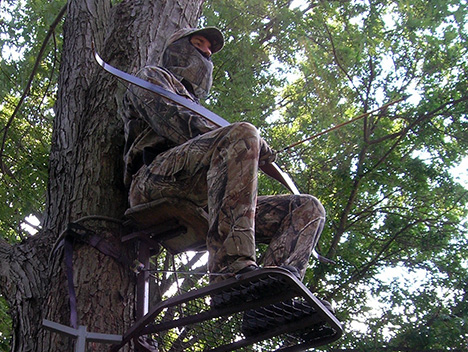 |
|||||||
| A hunter stand hunting from a tree. | |||||||
Stalking deer is an extremely difficult strategy to use in a forest. A hunter cannot see very far through the trees and vegetation. Also, he cannot quietly approach his prey unless the ground is wet or has a few inches of snow. Normally the forest floor has too much dry, crunchy debris. A deer’s excellent sense of hearing will often pick up the sound of an approaching hunter from a distance, allowing it to slip away undetected. Sometimes I need to switch forest stand hunting spots during the middle of the day. The distance between my stands can be as close as a few hundred yards or as far as a mile apart. If the ground is wet or has a few inches of snow, I will slowly and quietly hunt my way over to my other stand. If I spot or kick up deer, I still have the opportunity to shoot my weapon if I am within range. Not to cause confusion, but this strategy is called “still hunting.” It is not considered stalking. The word “still” does not mean the hunter remains still; it just means a hunter moves very slowly through the forest. Driving deer can be a very productive strategy to use in a forest, but it requires the coordination and cooperation of many hunters. I do have a handful of friends and relatives who hunt, but trying to get these guys together at the same time and place is almost impossible. Unfortunately, I seldom have the opportunity to use the driving strategy to hunt deer. There are many ways to stand hunt deer and it all depends on the environment. The goal of a stand hunter is to naturally blend into the environment by breaking up his silhouette. A stand hunter in a swamp might sit/stand in the brush or tall grass. A stand hunter in farm country might sit/stand against hay bails or a fence. A stand hunter in a forest might sit/stand next to a bush or small hill. However, most stand hunters in a forest will often choose to sit/stand against the most common thing in a forest: a tree. This popular forest hunting strategy is referred to as stand hunting from a tree. The vast majority of my successful hunting trips were the result of the stand hunting from a tree strategy. Stand hunting from a tree is my favorite deer hunting strategy for one major reason: it works! Deer have a very difficult time seeing a motionless hunter sitting or standing against a tree, especially if the hunter is wearing forest pattern camouflage. If the wind direction is favorable and if the hunter remains still, deer will usually not detect his presence. Even if a deer gazes directly at the motionless hunter, it will usually perceive the hunter to be a natural part of a tree. There are actually a few different stand hunting from a tree variations I use when deer hunting in a forest. No matter which variation I decide to use, I always wear forest pattern camouflage from head to toe. This includes a camouflage jacket, pants, hat, boots, facemask, and gloves. Even some of my hunting weapons are camouflaged. The only non-camouflage articles I occasionally wear are a blaze-orange hat and vest. This safety requirement is usually mandatory by game commissions during most deer firearms seasons. Lucky for us hunters, deer are orange color blind. The most basic stand hunting from a tree variation I use is to sit/stand against the base of a tree. I have successfully taken many deer with this simple hunting strategy. I use this strategy when hunting with a firearm or crossbow. Another stand hunting from a tree variation I use is to sit/stand against the base of a tree in a partial blind. I either construct a partial blind from natural materials (logs, branches, etc.) or I use a synthetic, camouflage partial blind. The partial blind allows me some freedom of movement because it conceals half of my body. I have harvested many deer with this hunting strategy. I usually use this strategy when hunting with a firearm or crossbow. Occasionally, I will use this strategy with a bow. Another effective stand hunting from a tree variation I use is to sit inside of a synthetic, camouflage full tent blind at the base of a tree. The tent blind allows me to move freely inside because it conceals most of my body. This fact is especially important when I’m bow hunting. Drawing and aiming a bow requires more movement than aiming a firearm or crossbow. I have had much success with this hunting strategy. I use the full tent blind when hunting with any type of firearm or archery equipment. The most elaborate stand hunting from a tree variation I use is to sit/stand high up against a tree on a man-made platform: a treestand. Hunting up high on a treestand has some additional advantages over hunting from the ground at the base of a tree. At a height of 16 – 18 feet, hunting from a treestand keeps my scent high off the ground. It also keeps me out of the deer’s usual line of sight; they tend to keep an eye out for predators at ground level, not up high in a tree. Elevated in a treestand, I can usually spot incoming deer at a greater distance. This gives me extra time to prepare and set up a proper shooting position with my hunting weapon. Being up high on a treestand also allows me a bit more freedom of movement with a decreased chance of being discovered by deer. Again, this fact is very important when drawing and aiming a bow. I have been very fortunate with this hunting strategy. I typically use this strategy when hunting with a bow, but sometimes with a firearm or crossbow. |
|||||||
| Stand hunting from a tree variations: | |||||||
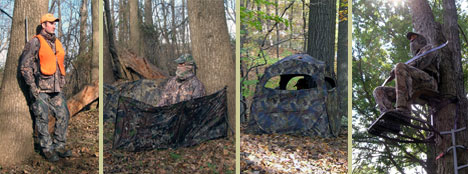 |
|||||||
|
|||||||
To read more about stand hunting from a tree variations, please visit the Tree Hunts section of this website. This section details five actual hunts from my hundreds of days afield. |
|||||||
Sitting/standing high up on a treestand, though an effective hunting strategy, can be potentially dangerous. One false step and a hunter can become seriously injured if he falls off of a treestand. Treestand manufacturers demand that all hunters wear safety harnesses while using their product. Hunters who are concerned with personal safety, myself included, will heed the manufacturers’ advice. In late September of 2006, I had a frightening experience while taking down a treestand. Little did I know, but my problems actually started the day before I stepped into the forest in an effort to retrieve a treestand. I have always been into working out on a regular basis. The previous day, I gave my chest a heavy workout at the gym. I did some bench presses and some dumbbell flyes. Dumbbell flyes is an exercise performed while lying flat on one’s back. It mainly targets the outer chest (pectorals), but also hits the upper arms (biceps) and front shoulders (deltoids). Champion bodybuilders use this exercise to shape and define their pectoral muscles for competition. It is a challenging exercise because it is very difficult to maintain perfect form during the entire motion of the exercise. To overcome this problem, fitness books and personal trainers recommend that you visualize yourself “hugging a tree.” When done correctly, the dumbbell flyes exercise will literally make a person a strong hugger. September is always a busy time for me at work, so I was spending long hours in the office. Unfortunately, I hadn’t been to the gym for a few weeks. The morning after my workout I realized the price I would pay for my extended absence: an extremely sore chest and aching upper arms. I almost canceled my hike into the forest to retrieve my treestand, but my chest and arms felt a little less sore by midday. I jumped in my truck and headed north out of the suburbs, through farm country, and up into the mountains. My treestand was a 2 mile hike into a large 25,000 acre forest. I had positioned it on the edge of a remote swamp a year before. I decided to finally take down this treestand because I had received permission to hunt land closer to my home. I needed to prepare my gear for the upcoming archery deer season. I arrived at the edge of the forest and parked my truck. I put on my backpack and started my forty-five minute hike into the woods. After reaching my treestand, I put on my safety harness and climbed up the pole ladder. My chest and biceps were still sore, but once I reached the top I was able to wrap my safety harness around the tree. I tried to disengage the clasp, which held my stand to the tree, but it was rusty and it did not want to budge. What did I expect after leaving it out in the elements for an entire year? This was my oldest and most beaten up treestand. I fumbled around with the clasp for a few minutes with no luck. The fact that I had a sore chest and aching arms was not helping the situation. I realized that I had to use a different pulling angle on the clasp, so I put my weight on my safety harness and leaned out to my left. I pulled hard with my left arm and the clasp finally came undone. Unfortunately, my body weight instantly flung out to the left and my feet slipped off the pole ladder. I did a hard face plant into the tree as my safety harness tightened around my waist. I was hugging the tree with my arms and my feet were dangling 17 feet off the ground! The only thing holding me up was my safety harness. I hung there for a bit and gathered my thoughts. I told myself, “Don’t panic.” All I had to do was get back on the pole ladder, which was off to my right. I extended my right leg around the tree and placed my foot on a rung. “Perfect!” I pushed down with my right leg, but my body swung out even more to the left on the safety harness. “Crap!” I just could not achieve the proper leverage from that angle. I was going to have to hug the tree extremely hard with my arms so my body would not swing out to the left again. I embraced that tree with all of my might. Even though my adrenaline was in full force, pain still shot through my sore chest and arms. Sweat was forming beads on my face. As I hugged the tree, I pushed down on my right foot and simultaneously pulled hard with my right arm. Intense pain coursed through my arms and up into my chest. I barely managed to pull myself back up and onto the pole ladder. Once I did, I let out a huge sigh of relief. I climbed down the pole ladder and took a long rest before going back up to finish dismantling the treestand. I sat there and realized how lucky I was that I had managed to get back on the pole ladder. If I had not found the strength, my only option would have been to unfasten my safety harness and drop 17 feet to the ground. This might not sound like an impressive height, but it is the equivalent of falling from the top of a two-story building. I probably would have survived the fall, but I definitely would have injured myself. Breaking a leg or twisting an ankle is a terrifying prospect for someone who was alone and 2 miles deep in a remote forest. I did have my cell phone and GPS unit in my backpack just in case something did go seriously wrong. Still, the scenario I went through really scared the hell out of me! A few weeks after the treestand incident, I was in Chicago on business. I decided to stay an extra day to see the sights. I woke up on October 6, 2006 very refreshed and excited to have the day to myself in Chi-Town. My first stop was the Field Museum of Natural History. I love the outdoors and nature, so this was the perfect museum for me. Plus, the Field Museum is the home of Sue: the largest Tyrannosaurus rex ever found. I remember reading about Sue many years ago, so I definitely wanted to check her out. It was not hard to find Sue once I walked into The Field Museum. I could see her from the admission desk, as she was proudly displayed in the main lobby. She had quite a crowd surrounding her. Sue grew larger and larger as I approached: Sue was huge! She was definitely bigger than the T. rex I once saw at the Academy of Natural Sciences museum in Philadelphia. I spent a good half an hour walking around her, taking photos from every angle. Then I headed upstairs and snapped more photos of Sue from the 2nd floor balcony. |
|||||||
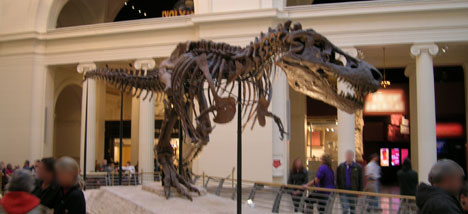 |
|||||||
| Sue – the world’s most famous Tyrannosaurus rex on display at the Field Museum of Natural History in Chicago. | |||||||
While I was upstairs, I checked out a display of Sue’s real head, a bronze replica of one of her arms, and a replica of her furcula (wishbone). I snapped photos of Sue’s spare parts. I found out that Sue’s real head was too heavy to mount onto her skeleton, so there was a lighter replica in place of it. I held my arm up to Sue’s arm replica; I found it amazing how small it was for an animal of Sue’s size. I read the plaque below, which referenced the big mystery of T. rex’s tiny arms and how, someday, Sue’s bones could help solve it. I had heard about the “tiny arm mystery” back in the early 1990’s when the first T. rex arm was discovered. I was very surprised that after fifteen years, the mystery had yet to be solved. After wandering through the rest of the museum for a couple of hours, I hopped a cab over to the Sears Tower. A high-speed elevator shot me to the top of the skyscraper where I spent an hour taking photos of the surrounding city. It was a crystal clear day, so I captured some great shots of Chicago from this birds-eye view. The following morning, I was on a plane headed home. Halfway through the flight, I opened my laptop, hooked up my camera, and downloaded my photos. First I checked out the awesome photos from the Sears Tower and then the ones from the Field Museum. I had taken a lot more photos of Sue than I thought. I eventually came to a few photos of Sue’s bronze arm replica. In the photos, I could see part of the plaque which referenced the big mystery of T. rex’s tiny arms. The more I thought about this mystery, the more curious I became. I made a mental note to find out more about this subject when I had some free time. A week later, I found myself in front of my computer surfing the web. I ran a search under “T. rex tiny arms” and hundreds of web hits popped up. I quickly found out that there are three possible T. rex arm theories recognized in Paleontology: 1. The arms were used for grasping prey. I only knew the basics of T. rex, but all three theories seemed like real possibilities to me. I wondered which theory was correct. I spent a few more hours on the web reading up on T. rex. I learned that T. rex’s arms had a very limited range of motion. The arms were so short that they could not reach T. rex’s mouth or even touch each other. I also found a lot of information on the debate over T. rex as predator vs. T. rex as scavenger. I found it very interesting that some paleontologists believe T. rex lived in forests. This fact really interested me because I am a forest hunter. I had an early business meeting the following morning, so I shut down my computer and went to bed. It took me quite some time to fall asleep because all I could think about was T. rex living in forests with its tiny arms. I hit the gym during my lunch hour the next day. I did a few chest exercises and worked my way over to my favorite machine: the chest flye. This popular machine hits the same chest and arm muscles as the dumbbell flyes exercise, but in an upright position. As I performed this “hugging a tree” exercise, I remembered my recent treestand incident and how I hard I embraced that tree with my aching chest and arms. With T. rex fresh on my mind, an idea popped into my head. I didn’t take this light bulb moment too seriously at first because it almost seemed absurd. However, the more I thought about it, the more I liked this ridiculous idea. So what was this crazy notion? What idea motivated me to spend my free time for the next two years conducting my own rough research and constructing this website? Like many paleontologists, I believe that T. rex was a hunter: a forest hunter. More specifically, I believe that T. rex used the very same hunting strategy that millions of forest hunters practice today: stand hunting from a tree. Of course, T. rex could not have sat or stood with its back against a tree like a human; T. rex’s tail would have made that position impossible. I believe T. rex would have faced a tree to settle into its hunting stance. T. rex’s tiny arms seemed custom-made to literally “hug a tree.” Could this be the answer to the T. rex tiny arm mystery? This posture would have allowed T. rex to blend itself against a tree and ambush prey very effectively. Once I returned home after having my light bulb moment, I turned on my laptop to see if this theory had occurred to anyone else. I typed in various word combinations of “tree” and “T. rex” into the search engine. I spent hours and hours reading over the search results. There were hundreds of hits, but mostly on T. rex family trees or clades. A few sites hinted that T. rex may have stalked or hid among trees to ambush prey, but that was the extent of it. These hunting descriptions were very general. There were no details or depictions of exactly how T. rex had used trees to ambush prey. Not one single hit mentioned T. rex possibly hugging a tree with its tiny arms while waiting to ambush prey. I was very surprised and at the same time confused. Surely I was not the first person to think of T. rex using the stand hunting from a tree strategy. Paleontologists must have looked into it before. Maybe they had, but never ran with it. Or maybe the thought simply never occurred to them. Other than humans, I do not think this hunting strategy really exists in the modern animal world. Maybe the stand hunting from a tree strategy had never been applied to T. rex. I suddenly remembered a vivid scene from that famous 1993 dinosaur blockbuster movie: A T. rex bursts out from a line of trees and into a clearing and ambushes a herd of running omnivore dinosaurs. The element of surprise works in the T. rex’s favor. It successfully attacks one of the omnivores. I thought this was a very clever and believable scene, although it did not show us what the T. rex was doing just prior to bursting out from the tree line. It would have been awesome if we saw part of an ambiguous tree (the T. rex) suddenly come alive just in time to attack the herd of omnivores as they passed by the forest’s edge. There was a potential problem I saw with T. rex using the stand hunting from a tree strategy: How did T. rex position its massive head against a tree? I grabbed a piece of paper to sketch out possible solutions. My brainstorming sketch session produced four separate drawings of T. rex: 1. T. rex standing, hugging a tree with its head off to one side I stared down at my drawings for a while. I just could not imagine T. rex being comfortable laying its head to one side for an extended period of time. I also did not believe T. rex would stand and hug a tree because this posture was not optimal for breaking up its silhouette. |
|||||||
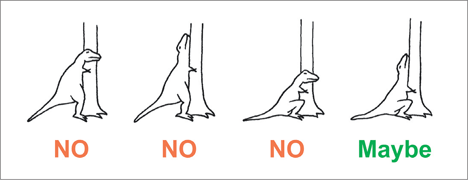 |
|||||||
| My brainstorm drawings of possible T. rex stand hunting from a tree postures. | |||||||
The only scenario which remained was T. rex sitting, hugging a tree with its head pointed straight up. This posture did seem to break up T. rex’s silhouette, although this did not seem to be the most dignified posture. It looked a bit like a happy dog mounted on someone’s leg! I thought of another potential problem: T. rex was looking straight up toward the sky. Shouldn’t T. rex be looking into the forest watching for prey? This seemed like a major visual disadvantage for T. rex. I sat there and tried to envision a solution to this problem. Nothing came to me. Was this the correct stand hunting from a tree posture for T. rex? The following morning, I walked into my yard and took a quick look around to see if any neighbors were watching. The coast was clear. I knelt down, hugged a tree and tilted my head straight up with my chin resting against the trunk. To my amazement, I could still see the horizon on both sides of the tree. The horizon was not in focus, but I could still make it out with my left and right peripheral vision. The horizon became clearer when I moved my eyes left or right. Humans have a much wider field of view than I had thought. I realized that if T. rex had an even wider field of view than humans, then it would have been able to see the horizon on each side of a tree more clearly. T. rex would have been able to see prey on the ground while keeping its head pointed straight up. I didn’t know much about T. rex’s eyesight or field of view, but I was hoping that paleontologists did so I could research the subject further. Most people have never ventured deep into a natural forest. People frequent parks, nature trails, and picnic spots; these areas are landscaped, manicured and maintained. T. rex trying to stand hunt from a tree in one of these unnatural forests would stick out like a sore thumb. Natural, untouched forests are much thicker with low vegetation. Every natural forest has a percentage of dead and dying trees. These dead and dying trees lean against other trees or lie flat on the ground. I believe T. rex stand hunting from a tree in a sitting position with its head pointed straight up could have mimicked a dead or dying tree. If this were the case, then T. rex’s silhouette would have blended in very well in a natural forest environment. |
|||||||
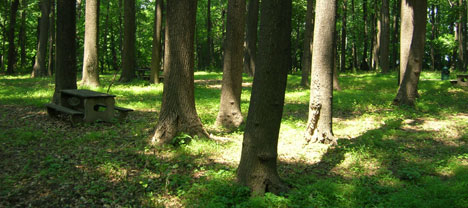 |
|||||||
| A typical picnic spot in a manicured and maintained unnatural forest. | |||||||
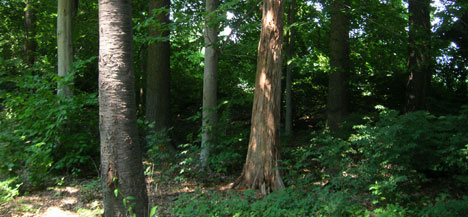 |
|||||||
| A typical natural forest with thick, low vegetation. | |||||||
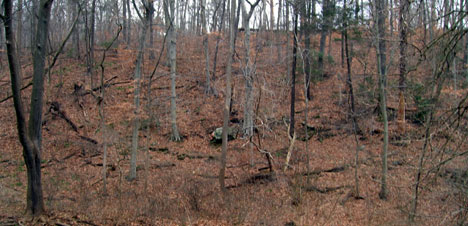 |
|||||||
| A typical natural forest in the winter season. A percentage of dead and dying trees is evident. | |||||||
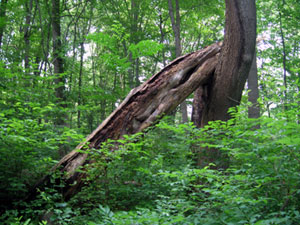 |
|||||||
A close-up of a dying tree. |
|||||||
| I was very excited about the possibility that T. rex used the stand hunting from a tree strategy. I decided to call my idea the Treeosaur theory. How cool would it be if T. rex and I really did share the same forest hunting strategy? My basic knowledge of T. rex was quite limited, so I realized I had to find out more about this fascinating theropod dinosaur. I needed to learn as much about T. rex as possible from the dinosaur experts: the paleontologists. I committed myself to spend much of my free time doing just that. To my relief, I learned that the Paleontology community is very generous and openly shares most of their T. rex research with the public. This information comes in the form of books, websites and even some videos. I hoped to gain valuable T. rex knowledge from expert paleontologists that would help support and possibly expand the Treeosaur theory. | |||||||
 Splash Page |